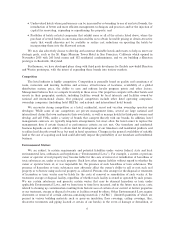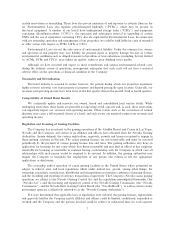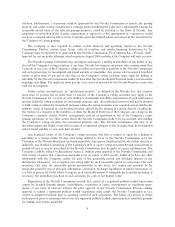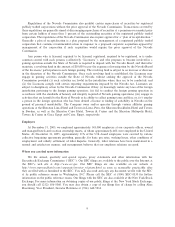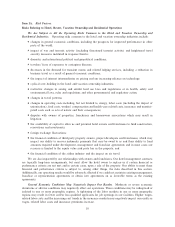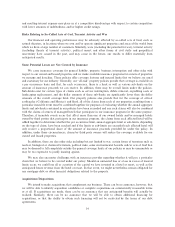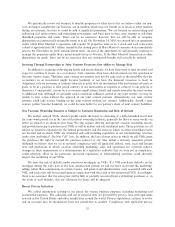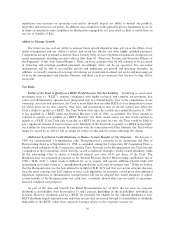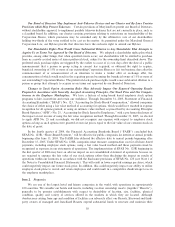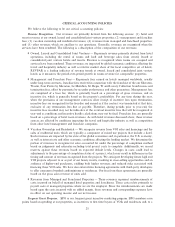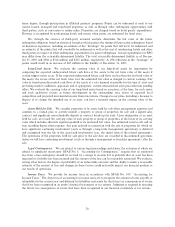Starwood 2005 Annual Report Download - page 20
Download and view the complete annual report
Please find page 20 of the 2005 Starwood annual report below. You can navigate through the pages in the report by either clicking on the pages listed below, or by using the keyword search tool below to find specific information within the annual report.regulations may increase our operating costs and/or adversely impact our ability to market our products,
properties and services to our guests. In addition, non-compliance with applicable privacy regulations by us (or
in some circumstances non-compliance by third parties engaged by us) may result in Ñnes or restrictions on
our use or transfer of data.
Ability to Manage Growth
Our future success and our ability to manage future growth depend in large part upon the eÅorts of our
senior management and our ability to attract and retain key oÇcers and other highly qualiÑed personnel.
Competition for such personnel is intense. Since January 2004, we have experienced signiÑcant changes in our
senior management, including executive oÇcers (See Item 10. ""Directors, Trustees and Executive OÇcers of
the Registrant'' of this Joint Annual Report). There can be no assurance that we will continue to be successful
in attracting and retaining qualiÑed personnel. Accordingly, there can be no assurance that our senior
management will be able to successfully execute and implement our growth and operating strategies. In
addition, we recently announced a strategy of reducing our investment in owned real estate and increasing our
focus on the management and franchise business, and there can be no assurance that our new strategy will be
successful.
Tax Risks
Failure of the Trust to Qualify as a REIT Would Increase Our Tax Liability. Qualifying as a real estate
investment trust (a ""REIT'') requires compliance with highly technical and complex tax provisions that
courts and administrative agencies have interpreted only to a limited degree. Due to the complexities of our
ownership, structure and operations, the Trust is more likely than are other REITs to face interpretative issues
for which there are no clear answers. Also, facts and circumstances that we do not control may aÅect the
Trust's ability to qualify as a REIT. The Trust believes that since the taxable year ended December 31, 1995,
it has qualiÑed as a REIT under the Internal Revenue Code of 1986, as amended. The Trust intends to
continue to operate so it qualiÑes as a REIT. However, the Trust cannot assure you that it will continue to
qualify as a REIT. If the Trust fails to qualify as a REIT for any prior tax year, the Trust would be liable to
pay a signiÑcant amount of taxes for those years. Similarly, if the Trust fails to qualify as a REIT in the future,
our liability for taxes would increase. In connection with the transaction with Host Marriott, the Trust will no
longer be owned by us and we will no longer be subject to this risk for actions following the closing.
Additional Legislation Could Eliminate or Reduce Certain BeneÑts of Our Structure. On January 6,
1999, we consummated a reorganization (the ""Reorganization'') pursuant to an Agreement and Plan of
Restructuring dated as of September 16, 1998, as amended, among the Corporation, ST Acquisition Trust, a
wholly owned subsidiary of the Corporation, and the Trust. Pursuant to the Reorganization, the Trust became
a subsidiary of the Corporation, which, directly, as well as indirectly through a wholly-owned subsidiary, holds
all the outstanding Class A shares of beneÑcial interest, par value $0.01 per share, of the Trust. The
Reorganization was proposed in response to the Internal Revenue Service Restructuring and Reform Act of
1998 (""H.R. 2676''), which made it diÇcult for us to acquire and operate additional hotels while still
maintaining our former status as a ""grandfathered paired share real estate investment trust.'' While we believe
that the Reorganization was the best alternative in light of H.R. 2676 and that our current structure does not
raise the same concerns that led Congress to enact such legislation, no assurance can be given that additional
legislation, regulations or administrative interpretations will not be adopted that would eliminate or reduce
certain beneÑts of the Reorganization and could have a material adverse eÅect on our results of operations,
Ñnancial condition and prospects.
As part of the Jobs and Growth Tax Relief Reconciliation Act of 2003, the tax rates on corporate
dividends to shareholders were decreased to 15 and 5 percent, depending on the shareholders' individual tax
brackets. However, dividends paid by a REIT are generally not eligible for the reduced dividend tax rate.
REIT dividends largely represent rents and other income that are passed through to shareholders as dividends
deductible to the REIT, rather than corporate earnings subject to the corporate income tax.
16


